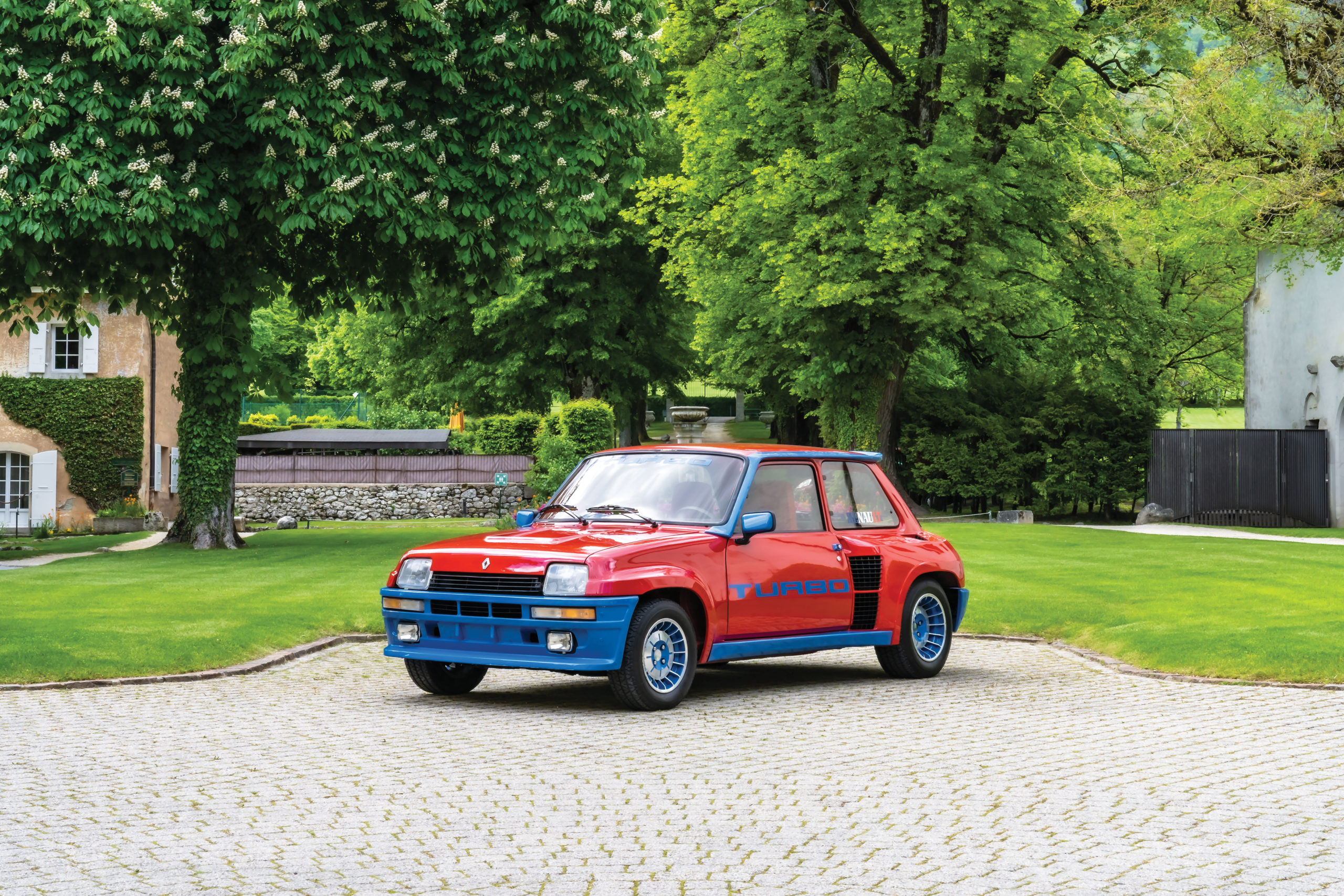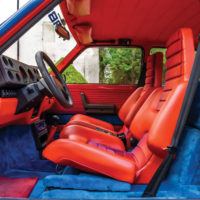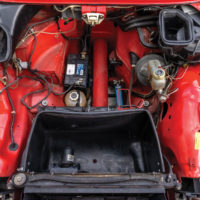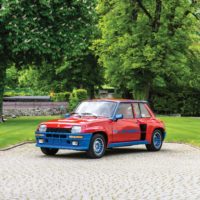SCM Analysis
Detailing
| Vehicle: | Courtesy of Bonhams |
| Years Produced: | 1980–85 |
| Number Produced: | 4,987 (1,820 Turbo 1, 3,167 Turbo 2) |
| SCM Valuation: | $86,000 |
| Chassis Number Location: | Plate riveted on right front inner fender |
| Engine Number Location: | Rear of rocker cover |
| Club Info: | Renault Turbo Owners club |
| Website: | http://www.rtoc.org |
| Alternatives: | 1971–84 Alpine A310, 1984 Peugeot 205 T16, 1999–2005 Renault Clio V6 Renault Sport |
| Investment Grade: | B |
This car, Lot 109, sold for $125,059 (CHF 115,000), including buyer’s premium, at Bonhams’ Bonmont sale in Chéserex, Switzerland, June 20, 2021.
These things still remind you of a grenade just waiting to go off. (Appropriately, the official name of the color is “Red Flash.”) If you want a reliable 160-hp engine, your ideal starting point probably wouldn’t be a 1,397-cc pushrod four. But that’s what Renault had, so that’s what it used.
The Renault 5 Turbo was devised as a competition car, and at the time Group 4 rules required that 400 production examples had to be built to qualify the model for international rallies. Renault had experience in turbocharging from F1, in which 700 hp was coaxed out of a 1,500-cc V6 (and ultimately 1,200 hp in qualifying trim, but that wasn’t until ’86). So slapping a Garrett T3 on the venerable “Cléon-Fonte” engine presumably made a sort of warped sense, as much for marketing as technical reasons.
Boiling over
It’s this that gives the Turbo its addictive character. There’s not much happening apart from noise below 3,000 rpm, so you have to keep it on the boil. The rear-biased weight distribution (40/60) is never far from the back of your mind as you ponder the wisdom of “chickening out” and lifting in corners. But with generous rubber at the naughty end, and a rear suspension essentially lifted from the Alpine A310, these cars are less twitchy than the bare numbers might lead you to imagine.
It’s hard not to love the raucous little screamer, as it’s the sort of car that no manufacturer could get away with building today. For its subsequent series of mid-engined hatches from 1998, Renault used a 3-liter V6 transplanted into the back of a Clio shell, but these were road cars rather than competition-oriented.
That A310 rear suspension is a clue that R5 Turbos were built by Alpine in Dieppe, France, after the bodywork mods had been designed by Marc Deschamps at Bertone. The 5-speed transmission came from the Renault 30. Though Renault eventually planned to sell 1,000 of these in the U.S., it never happened, so any U.S. cars for sale are later imports.
Motor upgrades
There are essentially three tiers of Turbo ownership, only slightly blurred by various motor upgrades. First, in 1980, there was just the Renault 5 Turbo, which sported a garish interior of unique Bertone-designed architecture trimmed in various clashing colors. It’s the sort of thing you might have expected in a 1970s concept car, just a decade too late. These have an aluminum roof and tailgate (plus the doors on the first 400, along with manual windows). Chassis numbers start with VF18220, echoing the original project number, 822, and all seem to have a B or C suffix.
Renault soon realized it could make some money from the project, so it started “adding profit” by eliminating some of the more costly features, eventually leading to the Turbo 2 in 1983. Thus, the early cars became retrospectively dubbed “Turbo 1.” Turbo 2s lost the aluminum roof and hatch in favor of stock Renault 5 steel, and run a disappointingly mundane (and usually beige) interior shared with the front-drive GT Turbo (itself a much tamer animal). Chassis numbers still start with VF18220, with an F suffix.
Of these, “200” (that’s the official number; the real count might have been less) were built to an “Evolution” spec in 1985 to obtain Group B homologation, using a slightly enlarged 1,432-cc motor. Renault used this model as the basis of the Tour de Corse and Maxi Turbo rally cars. These have chassis numbers starting with VF18221 and are the holy grail.
The numbers
Our subject car wasn’t an 18221, but it was a Turbo 1, which puts it fairly well up the hierarchy. Turbo 1s sell for more than 2s, and 18221s usually get a bit more — but not always. There are a few tatty cars out there, and many with questionable upgrades. (Is screwing up the boost to wring a “Cevennes-spec” 220 hp instead of the already-worrisome 160 out of the little pushrod motor really wise?) These examples tend to skew values. Witness the 18221 in the “Comps” column: It looked cheap at $72k, but that was because it was a neglected thing that needed a ton of work.
This one didn’t. A later Turbo 1, 1982-type car with steel doors and electric windows, it was presented in super order, showing 58,458 km (36k miles). Some of the wild interior is new repro, but overall it is in excellent condition, with no wear to the segmented velour seat bolsters. It’s complemented by a very ’80s Tamashi stereo which, matching the electric-blue carpets, almost looks in place.
The full toolkit remained under the lift-up lid on the parcel shelf/engine cover, which retained its clear plastic covering. The front-end panel fit was pretty good, suggesting it had never been crashed or significantly apart, and the, er, “individual” paint scheme is not uncommon on Turbos.
I asked Renault 5 Turbo expert Oliver Melliard, of Melliard of London, about the car. “Technically, the blue bits should be orange and the underlying parts of the car appear tired,” he said. “The blue carpet is lovely and original, amongst the best I have seen. The rest is a mixture of reproduction trim and original. Someone, I guess, has spent time and money making the appearance lovely, which is a good thing, but would likely need spending on mechanicals.”
Original is always best to collectors (though those who have to drive them may disagree) and this had everything going for it — good service history with just two owners, the last since 1990.
Turbo 1s have always fetched about 30% more than 2s. With decent Turbo 2s at about £60k–£65k in the U.K. ($80k–$90k in the U.S.), that still holds true here. We can say this example was correctly bought and sold. But with only 1,820 built, the buyer was lucky to find a nice Turbo 1 at all. ♦
(Introductory description courtesy of Bonhams.)



